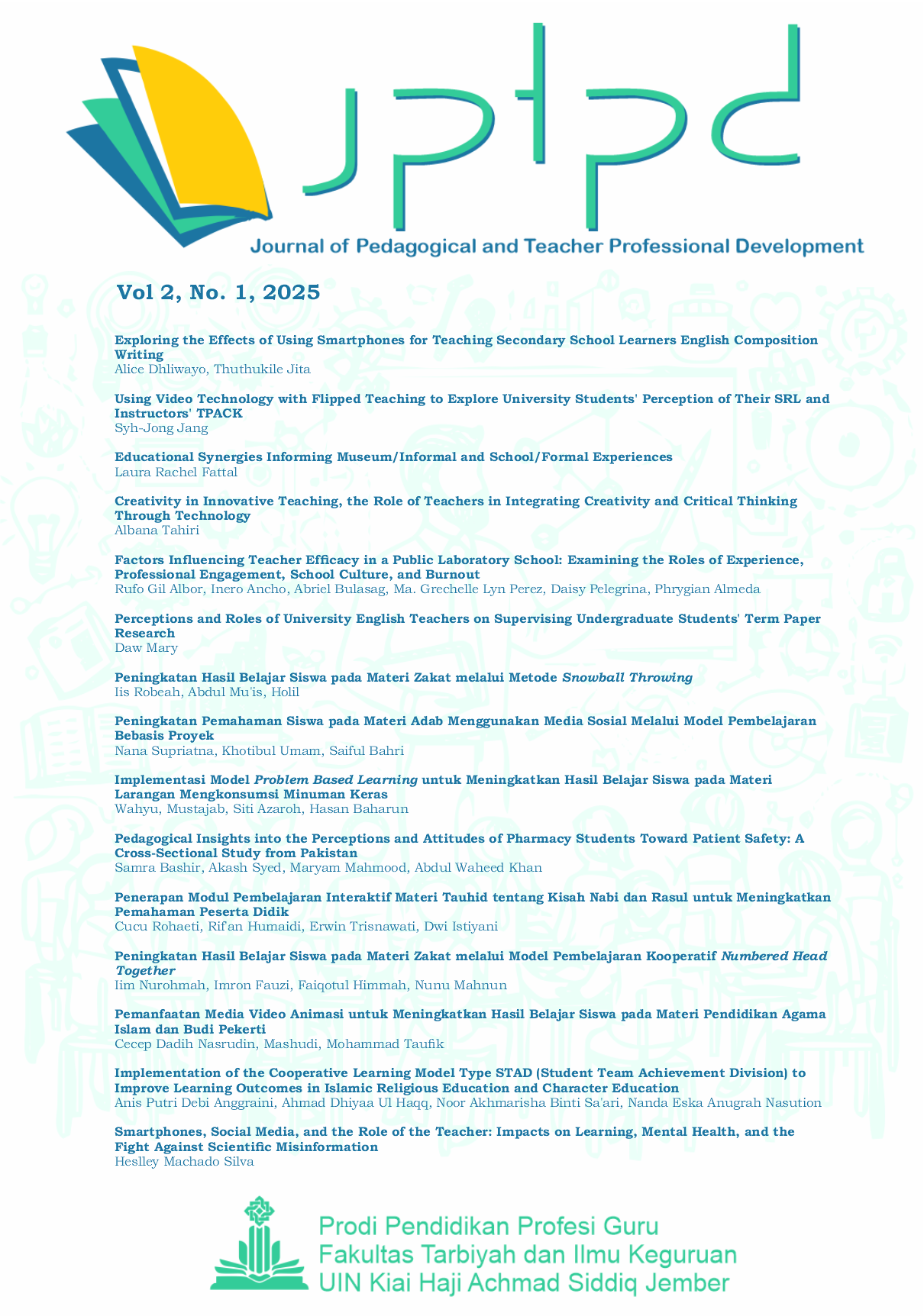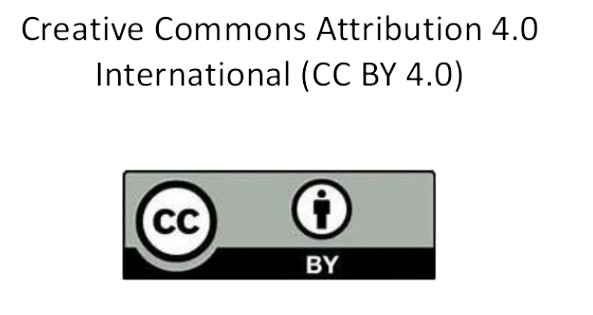Pedagogical Insights into the Perceptions and Attitudes of Pharmacy Students Toward Patient Safety: A Cross-Sectional Study from Pakistan
DOI:
https://doi.org/10.35719/jptpd.v2i1.955Keywords:
Clinical Pharmacy Clerkship, Medication Errors, Pakistan, Patient Safety, Pharmacy CurriculumAbstract
The study evaluated pharmacy students’ perceptions and attitudes toward patient safety at two universities in Islamabad, Pakistan. Final-year Pharm D students completed a 21-item self-administered questionnaire. Data were analyzed using SPSS (version 23.0). The survey had a 97% response rate (160/165 students). Most students (95.7%) believed pharmacists should contribute to patient care, and 69.4% agreed they should report medication errors. Additionally, 87.5% supported incorporating patient safety education in university curricula. However, 63% perceived that competent healthcare professionals don’t make harmful errors, and 50% believed only medical practitioners can identify the cause of errors. Furthermore, 42.5% thought most errors occur due to factors beyond healthcare professionals’ control. The findings indicate that while pharmacy students in Pakistan have positive attitudes toward patient safety, some misconceptions highlight a knowledge gap. Thus, integrating standardized patient safety courses into the pharmacy curriculum is recommended.
References
Abbas, M. R., Quince, T. A., Wood, D. F., & Benson, J. A. (2011). Attitudes of medical students to medical leadership and management: A systematic review to inform curriculum development. BMC Medical Education, 11, 93. https://bmcmededuc.biomedcentral.com/articles/10.1186/1472-6920-11-93
Alanazi, M., Tully, M., & Lewis, P. (2016). A systematic review of the prevalence and incidence of prescribing errors with high‐risk medicines in hospitals. Journal of Clinical Pharmacy and Therapeutics, 41(3), 239–245. https://onlinelibrary.wiley.com/doi/10.1111/jcpt.12389
Aldossary, S. A. (2019). Patient safety attitudes of clinical pharmacy students attending undergraduate program in King Faisal University. Pakistan Journal of Pharmaceutical Sciences, 32(1), 653–657. https://pubmed.ncbi.nlm.nih.gov/30720160/
Assiri, G. A., Shebl, N. A., Mahmoud, M. A., Aloudah, N., Grant, E., Aljadhey, H., et al. (2018). What is the epidemiology of medication errors, error-related adverse events and risk factors for errors in adults managed in community care contexts? A systematic review of the international literature. BMJ Open, 8(5), e019101. https://bmjopen.bmj.com/content/8/5/e019101
Bari, A., Khan, R. A., & Rathore, A. W. (2016). Medical errors: Causes, consequences, emotional response and resulting behavioral change. Pakistan Journal of Medical Sciences, 32(3), 523–528. https://pubmed.ncbi.nlm.nih.gov/27375682/
Fischer, M. A., Mazor, K. M., Baril, J., Alper, E., DeMarco, D., & Pugnaire, M. (2006). Learning from mistakes. Journal of General Internal Medicine, 21(5), 419–423. https://link.springer.com/article/10.1111/j.1525-1497.2006.00425.x
Flanagan, B., Nestel, D., & Joseph, M. (2004). Making patient safety the focus: Crisis resource management in the undergraduate curriculum. Medical Education, 38(1), 56–66. https://onlinelibrary.wiley.com/doi/10.1111/j.1365-2923.2004.01735.x
Halbach, J. L., & Sullivan, L. L. (2005). Teaching medical students about medical errors and patient safety: Evaluation of a required curriculum. Academic Medicine, 80(6), 600–606. https://journals.lww.com/academicmedicine/Fulltext/2005/06000/Teaching_Medical_Students_About_Medical_Errors_and.16.aspx
Henderson, D., Carson-Stevens, A., Bohnen, J., Gutnik, L., Hafiz, S., & Mills, S. (2010). Check a box. Save a life: How student leadership is shaking up health care and driving a revolution in patient safety. Journal of Patient Safety, 6(1), 43–47. https://journals.lww.com/journalpatientsafety/Fulltext/2010/03000/Check_a_Box__Save_a_Life__How_Student_Leadership.9.aspx
Leung, G. K., & Patil, N. G. (2010). Patient safety in the undergraduate curriculum: Medical students' perception. Hong Kong Medical Journal, 16(2), 101–105. https://pubmed.ncbi.nlm.nih.gov/20354243/
Leung, G., Ang, S., Lau, T. C., Neo, H. J., Patil, N. G., & Ti, L. K. (2013). Patient safety culture among medical students in Singapore and Hong Kong. Singapore Medical Journal, 54(9), 501–505. https://pubmed.ncbi.nlm.nih.gov/24068032/
Madigosky, W. S., Headrick, L. A., Nelson, K., Cox, K. R., & Anderson, T. (2006). Changing and sustaining medical students' knowledge, skills, and attitudes about patient safety and medical fallibility. Academic Medicine, 81(1), 94–101. https://journals.lww.com/academicmedicine/Fulltext/2006/01000/Changing_and_Sustaining_Medical_Students_.23.aspx
Nabilou, B., Feizi, A., & Seyedin, H. (2015). Patient safety in medical education: Students’ perceptions, knowledge and attitudes. PLOS ONE, 10(8), e0135610. https://journals.plos.org/plosone/article?id=10.1371/journal.pone.0135610
Pharmacy Council of Pakistan. (2013). Pharm D curriculum final 2013. https://www.pharmacycouncil.org.pk/doc/Pharm%20D%20Curriculum%20Final%202013.pdf
Shah, N., Jawaid, M., Shah, N., & Ali, S. M. (2015). Patient safety: Perceptions of medical students of Dow Medical College, Karachi. Journal of the Pakistan Medical Association, 65(12), 1261–1265. https://pubmed.ncbi.nlm.nih.gov/26712198/
Syed, A., Azhar, S., Raza, M. M., Saeed, H., & Jamshed, S. Q. (2018). Assessment of knowledge, attitude and barriers towards pharmacovigilance among physicians and pharmacists of Abbottabad, Pakistan. Pharmacy, 6(2), 29. https://www.mdpi.com/2226-4787/6/2/29
Tegegn, H. G., Abebe, T. B., Ayalew, M. B., & Bhagavathula, A. S. (2017). Patient safety attitudes of pharmacy students in an Ethiopian university: A cross-sectional study. Drug, Healthcare and Patient Safety, 9, 19–24. https://www.dovepress.com/patient-safety-attitudes-of-pharmacy-students-in-an-ethiopian-universi-peer-reviewed-fulltext-article-DHPS
Walpola, R. L., Fois, R. A., Carter, S. R., McLachlan, A. J., & Chen, T. F. (2015). Validation of a survey tool to assess the patient safety attitudes of pharmacy students. BMJ Open, 5(9), e008442. https://bmjopen.bmj.com/content/5/9/e008442
World Health Organization. (2011). Multi-professional patient safety curriculum guide. https://www.who.int/publications/i/item/multi-professional-patient-safety-curriculum-guide
Downloads
Published
How to Cite
Issue
Section
License
Copyright (c) 2025 Journal of Pedagogical and Teacher Professional Development

This work is licensed under a Creative Commons Attribution 4.0 International License.











